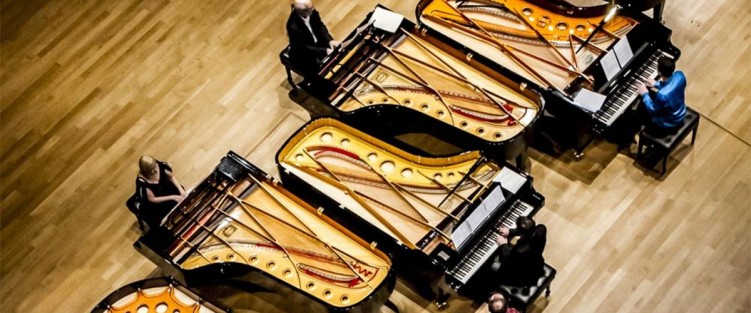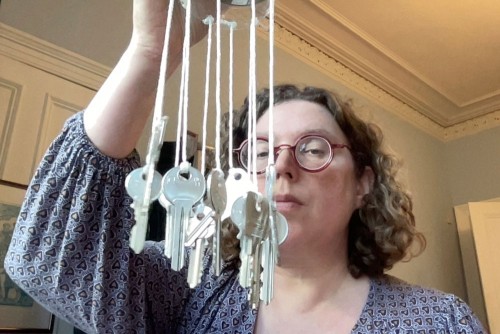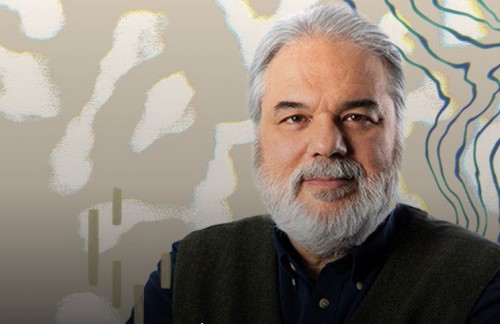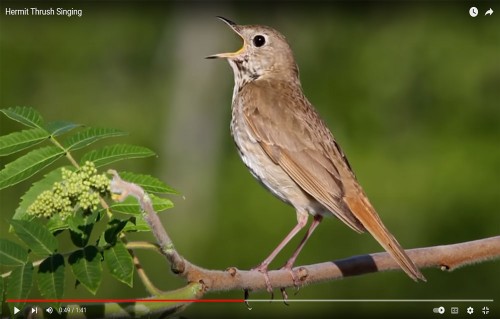 Women from Space: In last month’s issue, I wrote about the Women from Space festival, which happened from March 8-10. I was delighted to attend some of the events, and came away feeling inspired and energized by what I heard. The festival opener was a spectacular improvisation by Bloop, the duo made up of trumpeter Lina Allemano and her performance partner Mike Smith, whose electronics wizardry was fully on display in the effects processing he conjured from the equipment at hand. At times Allemano also played various gong instruments, such as a large cow-bell with one of her hands, adding different sonorities to the mix.
Women from Space: In last month’s issue, I wrote about the Women from Space festival, which happened from March 8-10. I was delighted to attend some of the events, and came away feeling inspired and energized by what I heard. The festival opener was a spectacular improvisation by Bloop, the duo made up of trumpeter Lina Allemano and her performance partner Mike Smith, whose electronics wizardry was fully on display in the effects processing he conjured from the equipment at hand. At times Allemano also played various gong instruments, such as a large cow-bell with one of her hands, adding different sonorities to the mix.
The evening ended with the explosive performances of the Women From Space Big Bang! 17-piece improvising collective, with most of the six commissioned works being conducted by the composers themselves. Each composer chose a song by Björk and created their own version from it. The band also included four singers whose vocals extended and added to the overall soundscapes. At times, it sounded like the roof was going to be blown off, the sounds were so magically intense. Throughout the performance, colourful and amoeba-like visual projections by The Liquid Crystal Display permeated the vaulted ceiling and walls of the Music Gallery stage area.
On the final evening of the festival, I managed to hear the performance by Matana Roberts on saxophone, Germaine Liu on percussion and Nicole Rampersaud on trumpet and electronics. The musical dialogue between these three virtuosos still lingers in my memory, each one of them taking turns to offer their own unique sound worlds before returning to create a cluster cloud of sound textures that arose from the dynamic combination.
Matana Roberts also included spoken voice in their performance, and at one point jammed extensively on various phrases from the American Pledge of Allegiance, probing the questions of what it really means to be free, and occasionally returning to “Liberty and justice for some” as a refrain. At the conclusion of the performance, they encouraged everyone to speak out on behalf of those who cannot speak for themselves, and upon leaving the stage, they proclaimed: “Free Palestine.”
Soundstreams: One of the intriguing upcoming events on the spring horizon, running April 18-20, is another three day event, Soundstreams mini-festival for multiple keyboards titled KEYED UP! Taking place at the Jane Mallett Theatre.
The opening concert of the festival on April 18 will be a special evening devoted to Bach’s Goldberg Variations. The first half of the concert is built around a performance of the complete Variations; as they are performed, each will be followed by a newly composed one commissioned from four Canadian composers (Taylor Brook, Dorothy Chang, Emily Doolittle and André Ristic). This will be followed, in the second half, by a North American premiere performance by Australian composer and pianist Paul Grabowsky of his Improvisations on the Aria from Bach’s Goldberg Variations.
 I reached out to Emily Doolittle, one of the commissioned composers, who explained that each composer was assigned either seven or eight of Bach’s variations, with the further instruction that they also write at least once for each of the four keyboard instruments that will be used in the performance: piano (Jackie Leung), harpsichord (Wesley Chen), organ (John Paul Farahat), and a Nord Stage 4 electronic keyboard (Gregory Oh).
I reached out to Emily Doolittle, one of the commissioned composers, who explained that each composer was assigned either seven or eight of Bach’s variations, with the further instruction that they also write at least once for each of the four keyboard instruments that will be used in the performance: piano (Jackie Leung), harpsichord (Wesley Chen), organ (John Paul Farahat), and a Nord Stage 4 electronic keyboard (Gregory Oh).
Doolittle was assigned variations 16 through 23 and decided to focus on Bach’s variation technique rather than on the original theme itself. She looked for what was stylistically characteristic of each of her assigned variations, whether it was a particular figure or gesture or rhythm and wrote her pieces based on that motif. Although she wrote her pieces, titled Varia, for the different keyboards, as instructed, she told me that she wanted the pieces to be adaptable to any type of keyboard instrument for future performances. “They can also be performed as a set on their own, and there’s a variety that if you were to listen to them one after the other, you’d hear certain patterns or chords, or textures that you might hear somewhere else in a different piece. There are little connections between the different pieces.”
(As it turns out, our conversation ranged far beyond her contribution to this event. See Emily Doolittle’s Evolving Creative Practice, below.)
The second KEYED UP concert on April 19, titled Notations, also consists of two distinct halves, and offers free admission. It opens with a series of world premieres by the six composers (Uko Abara, Alexandra Gorlin-Crenshaw, Gustav Knudson, Maria-Eduarda Mendes Martins, Prokhor Protasoff and Hsiu-Ping Patrick Wu) participating in Soundstreams week-long RBC Bridges Program, which offers free tuition and accommodation to six emerging Canadian and international composers. The complementary second half of the evening offers pieces by Ana Sokolović, Alvin Singleton, Monica Pearce and Ann Southam.
The big Finale concert on April 20 will feature three works for six grand pianos, including two iconic pieces, Steve Reich’s Six Pianos and Terry Riley’s A Rainbow in Curved Air, along with works by Julia Wolfe, André Ristic, and Ana Sokolović.
Emily Doolittle’s Evolving Creative Practice
What started out as a conversation focused on Emily Doolittle’s contribution to the upcoming Soundstreams #Keynotes event turned into a wide-ranging and thought-provoking discussion of her constantly evolving creative practice, worth repeating here.
On the subject of the Goldbergs, for example, she has her own very personal connections with the Variations, predating this commission. Because her young daughter has insomnia, over the past year one of the ways Doolittle has helped her fall asleep is by listening together to the Goldberg Variations. Sometimes this can take at least half an hour, so she knows those pieces really well by now. Another personal connection is with her former composition teacher Louis Andriessen. After a lesson, they would sight-read together various works by Bach. On a recent visit to Amsterdam after Andriessen’s passing, she was given his signed score of the Goldberg Variations as a gift to remember him by.
Birdsong: Another noteworthy aspect is her work with birdsong, in particular her interest in Hermit Thrush song. In her research, published in the Ecomusicology Review, she discovered how colonialism and nationalism impacted perceptions of North American birdsong. In the late 1700s, an influential European naturalist named Comte de Buffon wrote that the birdsongs of North America are “harsh, raucous and monotonous,” even though he himself had never left European shores. As Doolittle pointed out, “that’s exactly what European explorers heard when they arrived and often reported that the birds they heard squawked like a chicken. People hear what they’re expecting to hear. Obviously these European explorers were not talking with Indigenous people who no doubt were very well aware of the hermit thrush song,” she said.
It took the observations of North American-born writers, and in particular the pioneering publication of Quebec-born “Mrs. Sheppard of Woodfield,” in 1833 to begin changing settler attitudes. Based on her field observations, Sheppard argued that North American birdsong is appealing and pleasurable to hear and that the Hermit Thrush has a really wonderful song.
This interest in birdsong found its way into a recent project when Doolittle was commissioned to write 70 minutes of music for the audiobook version of Anne of Green Gables. She paired the different characters with bird songs found in Prince Edward Island or Nova Scotia, attempting to match each character’s personality with the attributes of the birdsong Anne would have heard in her environment.
As a long-time member of R. Murray Schafer’s Wolf Project and performing in many of his outdoor pieces, Doolittle’s interest in the connections between sound, music and the environment have deep roots and continue to evolve. She noted how birds would respond during the outdoor performances and also how Schafer incorporated birdsong into his pieces.
Ecological emergency: Another project she’s been involved with is a talk and concert series entitled Art-Making in the Anthropocene, co-led with colleagues Sarah Hopfinger and Stuart MacRae. This series explored how to approach creative work in this time of ecological emergency. When I asked her how these ideas impacted her own work, she said: “even though I’ve always cared about the environment, and have written music based on animal songs and natural soundscapes for over 25 years, my interest in natural sounds really comes from my curiosity about the sounds themselves.”
This is evident in one of her recent works where she began exploring sounds made by objects from the trash or recycling bins. For a commission from the Rainy Days festival in Luxembourg, she composed for a wide array of metal objects such as keys, molded pie foil containers and various sizes of tin cans. During the process of collecting and experimenting with the sound possibilities of these objects, she also gained valuable insights about packaging, visiting various grocery stores to purchase food in tin cans from different countries. One large and resonant tin can from Greece, filled with stuffed grape leaves, meant her family ate nothing but grape leaves for four days!
“That’s one piece that I wouldn’t have composed without the change in thinking fostered by the discussions of the Art-Making in the Anthropocene series”, she said. The resulting composition, titled (re)cycling I: metals, was performed in the fall of 2023 in Luxembourg by the Montreal-based Architek Percussion ensemble.
Third of three
The third event in this month’s account of recent and upcoming new music events is coincidentally another three-day festival. Titled "Future Resonance" and brought to us biennially by New Music Concerts, it takes place from April 26-28 in three different venues. It begins on April 26 at the Canadian Music Centre with a panel discussion titled “What Is the Real Sound of Toronto” aimed at stimulating a lively conversation about alternate ways of approaching the creation and presentation of newly made music. Doors open at 4:30pm and the event wraps up with a reception from 6:30pm to 7pm.
 On April 27, the action shifts to St. George by the Grange, the previous home of the Music Gallery, for the concert that promises to be the centrepiece of the festival, titled “Swara Sutras Goes Electronic.” “Swara sutras” in Sanskrit means an assemblage of notes, and the concert lives up to its title. In its first half, it offers four world premieres by Canadian composers where the sounds of guzheng, tablas, bamboo flute, percussion, kora, and Metis fiddle, are individually and in combination blended with new technologies. The concert’s final work features a nine-musician Swara Sutras Ensemble assembled for the occasion under the direction of Sandeep Bhagwati.
On April 27, the action shifts to St. George by the Grange, the previous home of the Music Gallery, for the concert that promises to be the centrepiece of the festival, titled “Swara Sutras Goes Electronic.” “Swara sutras” in Sanskrit means an assemblage of notes, and the concert lives up to its title. In its first half, it offers four world premieres by Canadian composers where the sounds of guzheng, tablas, bamboo flute, percussion, kora, and Metis fiddle, are individually and in combination blended with new technologies. The concert’s final work features a nine-musician Swara Sutras Ensemble assembled for the occasion under the direction of Sandeep Bhagwati.
The final event on April 28 takes the festival uptown to the Aga Khan Museum for a full-day immersive event titled “Śabdagatitāra: How to Inhabit These Different Temporalities?” “Śabdagatitāra” is again from Sanskrit meaning the crossing over (tāra) of methods of making (gati) sound (śabda), and promises to be an event “celebrating many musical roots and containing wonderfully unexpected sound worlds,” including pipa, Bulgarian singing, Turkish violin, double bass and musical sculptures.
Coming full circle, Soundstreams appears again on the calendar for a May 4 performance of Grandma’s Shawl, which reveals the story of the bond built in the early 20th century between Ukrainian and Indigenous women. Struggling to cope in their new surroundings, the Ukrainian immigrants are welcomed and supported by Indigenous women through food and Khustka shawls. The musical narrative for soprano, mezzo, piano and violin unfolds through the combining of works by both Ukrainian and Canadian composers, and takes place at the Redwood Theatre, a classic 1914 theatre, newly renovated, at 1300 Gerrard St in Toronto’s east end.
Wendalyn Bartley is a Toronto-based composer and electro-vocal sound artist. sounddreaming@gmail.com




